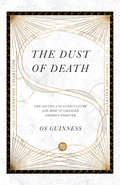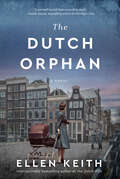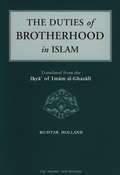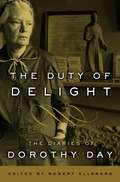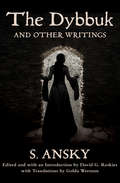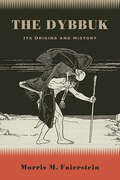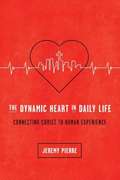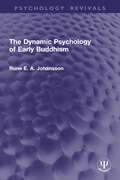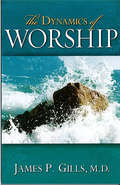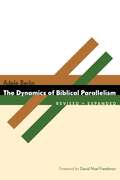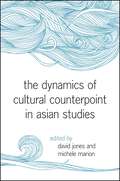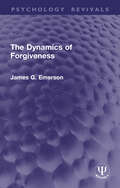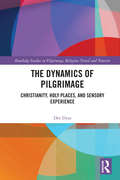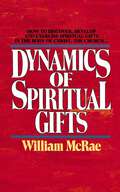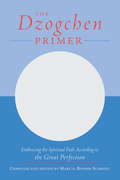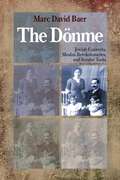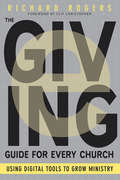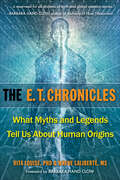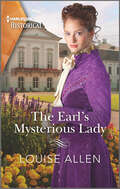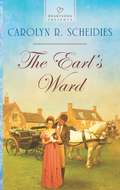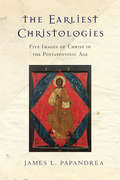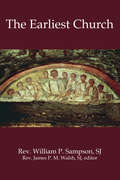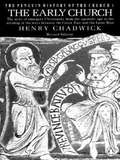- Table View
- List View
The Dust of Death: The Sixties Counterculture and How It Changed America Forever (The IVP Signature Collection)
by Os GuinnessIn 1968, at the climax of the sixties, Os Guinness visited the United States for the first time. There he was struck by an impression he'd already felt in England and elsewhere: beneath all the idealism and struggle for freedom was a growing disillusionment and loss of meaning. "Underneath the efforts of a generation," he wrote, "lay dust." Even more troubling, Christians seemed uninformed about the cultural shifts and ill-equipped to respond. Guinness took on these concerns by writing his first book, The Dust of Death. In this milestone work, leading social critic Guinness provides a wide-ranging, farsighted analysis of one of the most pivotal decades in Western history, the 1960s. He examines the twentieth-century developments of secular humanism, the technological society, and the alternatives offered by the counterculture, including radical politics, Eastern religions, and psychedelic drugs. As all of these options have increasingly failed to deliver on their promises, Guinness argues, Westerners desperately need another alternative—a Third Way. This way "holds the promise of realism without despair, involvement without frustration, hope without romanticism." It offers a stronger humanism, one with a solid basis for its ideals, combining truth and beauty. And this Third Way can be found only in the rediscovery and revival of the historic Christian faith. First published in 1973, The Dust of Death is now back in print as part of the IVP Signature Collection, featuring a new design and new preface by the author. This classic will help readers of every generation better understand the cultural trajectory that continues to shape us and how Christians can still offer a better way.
The Dutch Orphan: A Novel
by Ellen KeithFrom the author of The Dutch Wife comes a riveting novel set during World War II about two sisters, one of whom secretly adopts a Jewish baby and the other who is married to a Nazi sympathizer Amsterdam, 1941. When the Nazis invade Amsterdam, singer Johanna Vos watches in horror as her Jewish friends are forbidden from performing with her onstage, and the vibrant music scene she loves is all but erased. Johanna helps organize the Artists’ Resistance, an underground network that arranges for Jewish musicians to perform at house concerts hosted by their allies. When Johanna is told about a Jewish orphan who is headed for deportation, she does not think twice: she takes the baby in as her own, hiding the truth from everyone, including her sister, Liesbeth. Meanwhile, Liesbeth de Wit finds herself torn between her sister and her failing marriage. She knows Johanna is an ally of the Resistance, while her husband actively supports the Dutch Fascist Party. As the sisters navigate the ongoing Nazi occupation, they find themselves growing further and further apart. And when another charming member of the Dutch Fascist Party sets his eyes on Liesbeth, her predicament only deepens. As the war unfolds, secrets continue to grow between the sisters, severing their once-unbreakable bond. Eventually, both women are forced to make a choice that will alter their lives forever: the choice between family and freedom.
The Dutch Revolt and Catholic Exile in Reformation Europe
by Geert H. JanssenThe Dutch Revolt of the sixteenth century sparked one of the largest refugee crises of Reformation Europe. This book explores the flight, exile and eventual return of Catholic men and women during the war. By mapping the Catholic diaspora across Europe, Geert H. Janssen explains how exile worked as a catalyst of religious radicalisation and transformed the world views, networks and identities of the refugees. Like their Protestant counterparts, the displaced Catholic communities became the mobilising forces behind a militant International Catholicism. The Catholic exile experience thus facilitated the permanent separation of the northern and southern Netherlands. Drawing on diaries, letters and evidence from material culture, this book offers a penetrating picture of the lives of early modern refugees and their agency in the Counter-Reformation.
The Duties of Brotherhood in Islam
by Muhtar Holland Imam Al-GhazaliImam al-Ghazali explores the meaning and significance of fraternity in Islam in this brilliant essay from his seminal work, The Revival of the Religious Sciences, which covers material assistance, personal aid, holding one's tongue, speaking out, forgiveness, loyalty, sincerity, and informality.Table of Contents:ForewardTranslator's ForewordIntroduction: the Time and Place of al-GhazaliAl-Ghazali: On the Duties of BrotherhoodThe First Duty: Material AssistanceThe Second Duty: Personal AidThe Third Duty: Holding One's TongueThe Fourth Duty: Speaking OutThe Fifth Duty: ForgivenessThe Sixth Duty: PrayerThe Seventh Duty: Loyalty and SincerityThe Eighth Duty: InformalityPostscriptTranslator's NotesImam al-Ghazali (1058-1111 CE) of Tus in Iran was one of the greatest scholars in the history of Islamic thought. He made outstanding contributions in logic, philosophy, jurisprudence, legal theory, and mysticism.
The Duty of Delight: The Diaries of Dorothy Day
by Dorothy DayFor almost fifty years, through her tireless service to the poor and her courageous witness for peace, Dorothy Day offered an example of the gospel in action. Now the publication of her diaries, previously sealed for twenty-five years after her death, offers a uniquely intimate portrait of her struggles and concerns. Beginning in 1934 and ending in 1980, these diaries reflect her response to the vast changes in America, the Church, and the wider world. Day experienced most of the great social movements of her time but, as these diaries reveal, even while she labored for a transformed world, she simultaneously remained grounded in everyday human life: the demands of her extended Catholic worker family; her struggles to be more patient and charitable; the discipline of prayer and worship that structured her days; her efforts to find God in all the tasks and encounters of daily life. A story of faithful striving for holiness and the radical transformation of the world, Day's life challenges readers to imagine what it would be like to live as if the gospels were true.
The Dybbuk and Other Writings
by David G. Roskies S. Ansky Golda WermanThis volume presents The Dybbuk, S. Ansky’s well-known drama of mystical passion and demonic possession, along with little-known works of his autobiographical and fantastical prose fiction and an excerpt from his four-volume chronicle of the Eastern Front in the First World War, The Destruction of Galacia.
The Dybbuk: Its Origins and History (SUNY series in Western Esoteric Traditions)
by Morris M. FaiersteinThe Dybbuk is the first comprehensive study of the historical and kabbalistic sources of the dybbuk phenomenon, from the first recorded case of dybbuk possession in Safed in 1571 onward. Dybbuk possession differs from possession by demons or Satan. Its origin is in the Kabbalistic concept of gilgul (transmigration) for sins that are so grievous that Gehenna is not sufficient punishment, and the soul must therefore wander until expiation is found. The dybbuk can temporarily find refuge in animals or people and can only be exorcised by a Baal Shem, a great kabbalist or expert in Jewish magic. In addition to describing the history and evolution of this concept, The Dybbuk includes English translations of all dybbuk stories discussed in the book, many translated for the first time.
The Dynamic Heart In Daily Life: Connecting Christ To Human Experience
by Jeremy PierreOur hearts are not steel. They are living, complex things that grow and change. Sometimes they fly so high we scrape the top of heaven. Sometimes they barely make it off the ground. Sometimes they feel buried under the ground. What hope do we have of understanding ourselves when we are so changeable? And what hope do we have for lasting change when our response to life is so different from one day to the next? But God designed our hearts to be both varied and varying, and he delights in his craftsmanship. He made our hearts to respond to life in a wide, beautiful spectrum of thought, desire, and choice. This spectrum bends, adapts, expands, and contracts as it dynamically responds to changing situations. The goal of change is not to flatten this variety, but to guide our responses so they reflect who we are in Christ. Jesus perfectly lived his humanity out as a dynamic being. Now as our risen Savior, he redeems all of human experience for his purposes. Without a holistic understanding of people, our approach to those in need of help will be lopsided, focusing on just one aspect of human experienceperhaps simply trying to correct faulty thinking, to stir different emotions, or to correct wrong actions. Focusing on one of these aspects of human experience to the exclusion of the others does not do justice to Gods design. Jeremy Pierre, in this ground-breaking book, lays out a holistic understanding of who we are and how we change through a dynamic relationship with Christ. Every day our dynamic hearts need help from our dynamic Savior.
The Dynamic Psychology of Early Buddhism (Psychology Revivals)
by Rune JohanssonOriginally published in 1979, The Dynamic Psychology of Early Buddhism was a psychologist’s attempt to understand what the Buddha meant by “dependent origination” (paticcasumappāda, sometimes translated as “causality”). Those who are familiar with Theravada Buddhism have met the famous series of twelve links in the chain of causation (nidanas) of which each is said to be the condition of the next one, and the background of this book is exactly the challenging, teasing incomprehensibility of this series. The author collected all the passages in the Nikāyas or scriptural literature which throw light on the meaning of conditioned sequences, accepting only those explanations which agree with the facts in the Nikāyas. The result of these investigations is that the dynamic aspect of the Buddha’s psychology must have been much more extreme and all-pervading than was usually believed at the time of first publication. Today it can be read in its historical context.
The Dynamics Of Worship
by Dr. James P. GillsJames P. Gills, MD, gives biblical wisdom about the worship of God in a context that touches and changes the reader's heart. Study questions for groups or individuals are provided after each chapter.
The Dynamics of Biblical Parallelism (The Biblical Resource Series)
by Adele BerlinUnderstanding of biblical poetry is enhanced by the study of its structure. In this book Adele Berlin analyzes parallelism, a major feature of Hebrew poetry, from a linguistic perspective. This new edition of Berlin's study features an additional chapter, "The Range of Biblical Metaphors inSmikhut,"by late Russian linguist Lida Knorina. Berlin calls this addition "innovative and instructive to those who value the linguistic analysis of poetry." It is a fitting coda to Berlin's adept analysis.
The Dynamics of Cultural Counterpoint in Asian Studies (SUNY series in Asian Studies Development)
by David Jones; Michele MarionContributors give contemporary presence to Asian studies through a variety of themes and topics in this multidisciplined and interdisciplinary volume. In an era of globalization, scholars trained in Western traditions increasingly see the need to add materials and perspectives that have been lacking in the past. Accessibly written and void of jargon, this work provides an adaptable entrée to Asia for the integration of topics into courses in the humanities, social sciences, cultural studies, and global studies. Guiding principles, developed at the East-West Center, include noting uncommon differences, the interplay among Asian societies and traditions, the erosion of authenticity and cultural tradition as an Asian phenomenon as well as a Western one, and the possibilities Asian concepts offer for conceiving culture outside Asian contexts. The work ranges from South to Southeast to East Asia. Essays deal with art, aesthetics, popular culture, religion, geopolitical realities, geography, history, and contemporary times.
The Dynamics of Forgiveness (Psychology Revivals)
by James G. EmersonFirst published in 1964, The Dynamics of Forgiveness is the product of a parish and of theological study in the context of a parish. Written by a pastor, it attempts to give enough evidence to establish the place of forgiveness in theological thought, parish life, and personal health. The experiences presented have been subjected to investigation by tested procedures. The author states that he is not a church historian, a systematic theologian, or an authority on human behavior. However, he wished to raise questions for those that are experts in these disciplines and hoped that this book would raise a response.This book is a re-issue originally published in 1964. The language used is a reflection of its era and no offence is meant by the Publishers to any reader by this re-publication.
The Dynamics of Jewish Latino Relationships: Hope and Caution
by Bridget KevaneThe Dynamics of Jewish Latino Relationships centers around three themes: immigration, race and identity, and faith and religion. Each chapter explores an encounter that, for various reasons, has brought Latinos and Jews together on the same stage.
The Dynamics of Pilgrimage: Christianity, Holy Places, and Sensory Experience (Routledge Studies in Pilgrimage, Religious Travel and Tourism)
by Dee DyasThis book offers a systematic, chronological analysis of the role played by the human senses in experiencing pilgrimage and sacred places, past and present. It thus addresses two major gaps in the existing literature, by providing a broad historical narrative against which patterns of continuity and change can be more meaningfully discussed, and focusing on the central, but curiously neglected, area of the core dynamics of pilgrim experience. Bringing together the still-developing fields of Pilgrimage Studies and Sensory Studies in a historically framed conversation, this interdisciplinary study traces the dynamics of pilgrimage and engagement with holy places from the beginnings of the Judaeo-Christian tradition to the resurgence of interest evident in twenty-first century England. Perspectives from a wide range of disciplines, from history to neuroscience, are used to examine themes including sacred sites in the Bible and Early Church; pilgrimage and holy places in early and later medieval England; the impact of the English Reformation; revival of pilgrimage and sacred places during the nineteenth and twentieth Centuries; and the emergence of modern place-centred, popular 'spirituality'. Addressing the resurgence of pilgrimage and its persistent link to the attachment of meaning to place, this book will be a key reference for scholars of Pilgrimage Studies, History of Religion, Religious Studies, Sensory Studies, Medieval Studies, and Early Modern Studies.
The Dynamics of Spiritual Gifts
by William J. McraeOur churches have hardly begun to tap the potential in the pews. Many Christians have settled for far less than God intends because many have never discovered or developed their spiritual gifts. "An understanding of Ephesians 4:11-16 has changed my entire perspective on my Christian service. I discovered that one of my highest priorities must be equipping the saints for their work of service. Pursuing this objective I have made a second discovery. Exceedingly few believers are conscious of possessing a spiritual gift, and even fewer know what their gift is or what to do about it. My third discovery is that few things can be of greater assistance to a Christian in setting his own priorities or discerning the will of God than knowing his own gift. These are the discoveries that have motivated me to prepare this book," says the author. Included are chapters on: - The Definition of a Gift - The Distribution of the Gifts - A Description of the Gifts - The Distinctions Within the Gifts.
The Dzogchen Primer: An Anthology of Writings by Masters of the Great Perfection
by Marcia Binder SchmidtThe Tibetan Buddhist meditation practice known as Dzogchen (pronounced ZOG-chen) is a practical method for accessing the pristine, clear awareness that lies beneath the chatter and confusion of our daily thoughts. The Dzogchen Primer provides the keys for understanding Dzogchen and putting it into practice. Marcia Schmidt, a long-time Buddhist practitioner, has gathered here the most accessible, down-to-earth writings published on this subject and has organized them into a study guide for the serious beginner on the Buddhist path. The collection includes writings from such well-known and venerable masters as Milarepa, Padmasambhava, Shantideva, Chögyam Trungpa, and Tulku Urgyen. The concept of Dzogchen is said to lie beyond the confines of our beliefs, our intellectual constructs, our ordinary understanding. A Dzogchen master writes, "We need to dismantle our fixation on the permanence of what we experience. A normal person clings to his experiences as being 'real,' concrete, and permanent. But if we look closely at what happens, experience is simply experience, and it is not made out of anything. It has no form, no sound, no color, no taste, no texture; it is simply empty cognizance." The Dzogchen Primer includes an informative editor's preface as well as two forewords by prominent Tibetan masters that provide fundamental background information that will be helpful to readers new to this subject. The book also includes short, descriptive guiding notes intended to assist both independent students and teachers leading workshops.
The Dönme
by Marc David BaerThis book tells the story of the Dönme, the descendents of Jews who resided in the Ottoman Empire and converted to Islam along with their messiah, Rabbi Shabbatai Tzevi, in the seventeenth century. For two centuries following their conversion, the Dönme were accepted as Muslims, and by the end of the nineteenth century rose to the top of Salonikan society. The Dönme helped transform Salonika into a cosmopolitan city, promoting the newest innovation in trade and finance, urban reform, and modern education. They eventually became the driving force behind the 1908 revolution that led to the overthrow of the Ottoman sultan and the establishment of a secular republic. To their proponents, the Dönme are enlightened secularists and Turkish nationalists who fought against the dark forces of superstition and religious obscurantism. To their opponents, they were simply crypto-Jews engaged in a plot to dissolve the Islamic empire. Both points of view assume the Dönme were anti-religious, whether couched as critique or praise. But it is time that we take these religious people seriously on their own terms. In the Ottoman Empire, the Dönme promoted morality, ethics, spirituality, and a syncretistic religion that reflected their origins at the intersection of Jewish Kabbalah and Islamic Sufism. This is the first book to tell their story, from their origins to their near total dissolution as they became secular Turks in the mid-twentieth century.
The E-Giving Guide for Every Church: Using Digital Tools to Grow Ministry
by Richard RogersThe purpose of this book is to help churches raise more money for ministry and mission by better using electronic media. Although philanthropy in the US is growing, churches continue to receive a declining portion of that philanthropy. Part of the challenge is that America is becoming significantly less dependent on paper currency (cash and checks) yet the church continues to count on paper currency as their primary media for donations. There have been warning signals for several years. Many churches face shrinking budgets and membership and are beginning to ask the right questions. The author's goal is to capture this teachable moment with a resource that will encourage pastors and church leaders to utilize tools already available to change the trajectory of their resourcing; because nothing is more important than what God has called them to do.The banking and electronic giving industries have not made it easy for churches to understand their services or fees. This book will take the confusion and fear away and open churches to new possibilities.
The E.T. Chronicles: What Myths and Legends Tell Us About Human Origins
by Rita Louise Wayne LalibertéThe E.T. Chronicles is a startling and comprehensive examination of ancient myths and legends that describe extraterrestrial visitors and their encounters with humanity since the dawn of time. Organized into a chronology that starts with "in the beginning" and ends with the advent of civilization, it brings together myths from many cultures (including the Sumerians, the Greek, the Maya and the Aborigines of Australia) and explores them in the context of current scientific discoveries. The result is a mind-blowing re-visioning of human origins through close reading of ancient texts relating to: • creation• gods and goddesses• heaven• the gods and their toys (space ships or chariots?)• the quest for immortality Could it be that those ancient stories of the gods were more than just the product of someone's fanciful imagination? Is it possible that the writers, chroniclers, and scribes of our distant past actually record an accurate view of our origin? Could it be that we are really children of the stars?
The Earl's Mysterious Lady
by Louise AllenA dramatic Regency romp from this bestselling author!An unexpected reunion…With the earl she left at the altar… Viola fled her arranged marriage to Guy Thurlow, Earl of Easton, right at the altar steps. Now she is Cressida Williams and greatly changed—so much so that when Guy finds her trespassing on his neglected estate, he doesn&’t recognize his runaway bride. As they work together to restore his grounds, desire flares. But she must deny his temptation because it would be socially ruinous if he discovered who she really is…From Harlequin Historical: Your romantic escape to the past.
The Earl's Ward
by Carolyn R. ScheidiesANGELLA DENNING NEEDS A PROTECTOR After rescuing her from near ruin, the Earl of Lucashire dutifully takes in the vicar's orphaned daughter. But he discovers Angella is a beauty too lovely to ignore. Soon the rakish earl is falling for his innocent ward. Despite his reputation, Angella has no choice but to place herself under the earl's protection. Even as she resists his charms, when he accepts her faith as his own, she finds herself drawn to him. But then a secret from his past threatens their growing bond. Is it possible her beloved protector is not the man she believes him to be?
The Earliest Christologies: Five Images of Christ in the Postapostolic Age
by James L. PapandreaThe second century was a religious and cultural crucible for early Christian Christology. Was Christ a man, temporarily inhabited by the divine? Was he a spirit, only apparently cloaked in flesh? Or was he the Logos, truly incarnate? Between varieties of adoptionism on the one hand and brands of Gnosticism on the other, the church's understanding took shape. In this clear and concise introduction, James Papandrea sets out five of the principal images of Christ that dominated belief and debate in the postapostolic age. While beliefs on the ground were likely more tangled and less defined than we can know, Papandrea helps us see how Logos Christology was forged as the beginning of the church's orthodox confession. This informative and clarifying study of early Christology provides a solid ground for students to begin to explore the early church and its Christologies.
The Earliest Church
by William P. Sampson“Exciting reading for anyone who wants to experience the initial development of Christianity as the work of humans essentially just like us.” —David Goldfrank, Professor of History, Georgetown University This book brings to life the lived experience of the disciples after Christ’s death, the possibilities they faced, and the choices they made—and how these all shaped the direction the Church would take. “In The Earliest Church, the late Rev. William P. Sampson, SJ, takes us on a journey of imagination, spirit, and theological contemplation. By helping us to explore the earliest days of the Church, he guides us into a deeper understanding of our Church in the present day. Just as Fr. Sampson guided so many on spiritual retreats, this book continues his legacy of scholarship, reflection, and helping others to most authentically live their faith.” —John J. DeGioia, President, Georgetown University “Applies a unique combination of historical and exegetical imagination and scholarly rigor to reconstruct the hypothetical journey of the direct and indirect disciples of Jesus from their considering him to have been an extraordinary man to their envisioning him also as God.” —David Goldfrank, Professor of History, Georgetown University “A fascinating exploration of how the religious experience continues to open up new insights into the past and the meaning of the Christian perspective. It provides a new analysis for readers seeking to know the history and contemporary unfolding of Christianity as seen in the early development of the church.” —Dr. Ronald Johnson, Professor Emeritus of History, Georgetown University
The Early Church
by Henry ChadwickExamines the beginning of the Christian movement during the first centureis AD, and the explosive force of its expansion throughout the Roman world.
